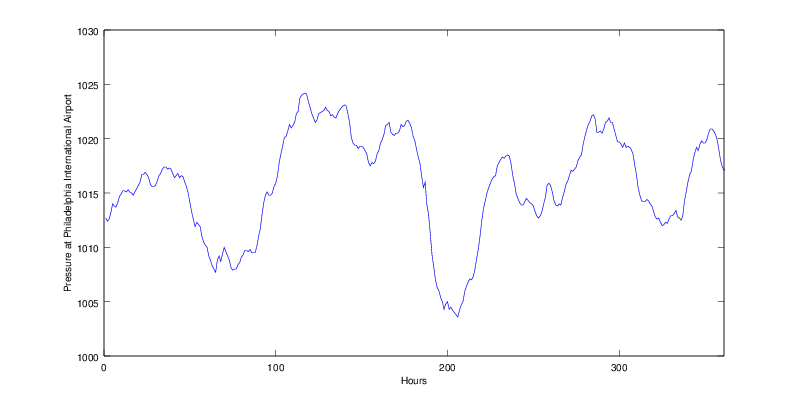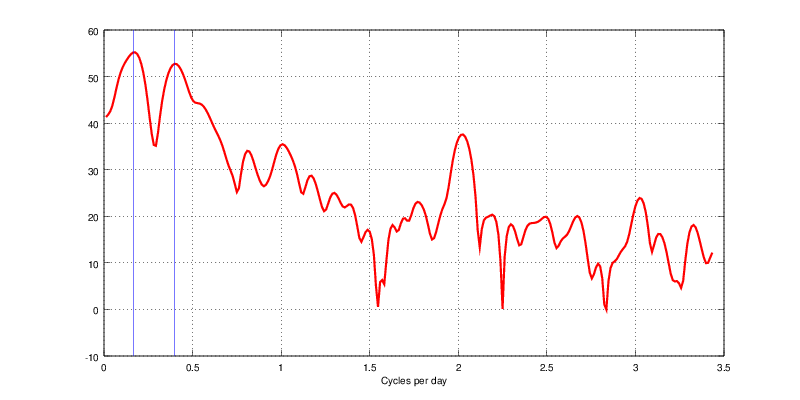The sounds of weather
« previous post | next post »
Since sound is just variation in ambient air pressure, you could think of speech as being like really fast weather in your mouth. I traditionally make a lame joke about this in Intro Phonetics, and the other day I decided to cash the humor in on some facts. Here are the past couple of weeks of barometric pressure observations at Philadelphia International Airport:
The log power spectrum from the Discrete Fourier Transform of (a windowed version of) that signal:
The peaks near 1, 2, and 3 cycles per day are from the "atmospheric tides":
The largest amplitude atmospheric tides are generated by the periodic heating of the atmosphere by the Sun – the atmosphere is heated during the day and not heated at night. This regular diurnal (daily) cycle in heating generates tides that have periods related to the solar day. It might initially be expected that this diurnal heating would give rise to tides with a period of 24 hours, corresponding to the heating's periodicity. However, observations reveal that large amplitude tides are generated with periods of 24 and 12 hours. Tides have also been observed with periods of 8 and 6 hours, although these latter tides generally have smaller amplitudes. This set of periods occurs because the solar heating of the atmosphere occurs in an approximate square wave profile and so is rich in harmonics. When this pattern is decomposed into separate frequency components using a fourier transform, as well as the mean and daily (24-hr) variation, significant oscillations with periods of 12, 8 and 6 hrs are produced.
1 cycle per day is 1/86400 Herz, i.e. about 15.6 μHz, and 2 and 3 cycles per day (periods of 12 and 8 hours) are about 23.1 μHz and 34.7 μHz. The actual peaks are slightly above 1 and 2 and 3 cycles per day, I presume because the days are getting shorter at this time of year.
I've placed vertical blue lines to make the peaks at 1/6 of a cycle per day (one cycle every six days = 1.93 μHz) and 2/5 of a cycle per day (one cycle every two-and-a-half days = 4.63 μHz). I presume that these correspond to the quasi-oscillatory behavior of the jet stream, i.e. weather fronts passing by.
There's seasonal variation as well, at least in the intensity of the jet stream oscillations, and from the hourly data on file at http://cdo.ncdc.noaa.gov/qclcd_ascii/, we can arrange to hear it. I've taken almost eight years of hourly barometric pressure data from PHL — from 00:54 on 5/1/2007 to 01:54 on 11/13/2014 — and written it out as a .wav file at 8000 samples per second, 8000*24*60*60 = 691,200,000 times faster. Since one year is 365*24*60*60 = 31,536,000 seconds, one cycle per year is 1/31536000 = 3.170979e-08 or about 31.7 nanoHertz.
But we only have hourly samples, so each year is represented by 365*24 = 8,760 numbers, and each year thus takes 1.095 seconds to go by at 8000 samples per second. So if you listen, you can hear almost eight years' worth of seasons at Philadelphia International Airport passing by in this audio clip:
Here's the same numbers at 16000 Hz sample rate:
Here's a version at 2000 Hz sample rate, where the seasonal variation is less salient, but the dominant modes of the atmospheric tides come out more strongly (2000/12 = 167 Hz, 2000/24 = 83 Hz)):
Or all three at once:
But no spooky voices whispering secret messages, I'm afraid. Maybe with some additional processing…


LMorland said,
November 15, 2014 @ 11:08 pm
I like the rhythm!
On a related note, comets sing: https://soundcloud.com/esaops/a-singing-comet
Nicki said,
November 16, 2014 @ 5:24 am
This reminds me of Night Vale. The sounds of the weather there are often quite pleasant. http://commonplacebooks.com
Gregory Kusnick said,
November 17, 2014 @ 1:09 am
Presumably at least part of the 2 cycle/day peak is attributable to lunar gravitational tides, which affect the atmosphere as well as the oceans.
Mark W. said,
November 17, 2014 @ 7:59 am
Gregory Kusnick: I was wondering about that, so I checked the Wikipedia article linked by myl. The article mentions this effect, explaining that the lunar gravitational effect is much weaker than the solar heating effect. This paper quantifies "much weaker", explaining that the lunar effect is about 20 times weaker than the solar effect.
On the actual topic of the post, I wonder what kind of sound would be produced by the most extreme pressure events (hurricanes). A comparison of the Philadelphia readings to readings from a hurricane-prone city might be interesting.
Ken said,
November 17, 2014 @ 9:49 am
Maybe the secret messages are encoded in the temperature. ;-)
You could try converting pressure and temperature simultaneously, and perhaps do a frequency shift on one of them to create something like formants.
DCA said,
November 17, 2014 @ 3:07 pm
Actually, the lunar atmospheric tide is driven mostly by the ocean tides pushing on the atmosphere from the bottom, rather than the lunar attraction.